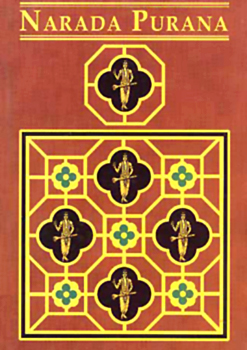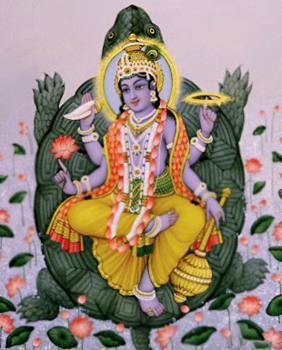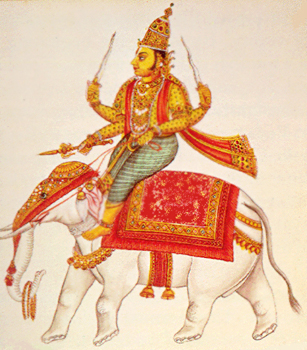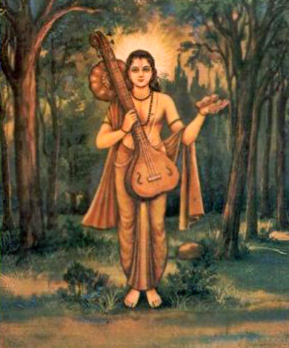 The crux of the philosophy of Narada Purana is that one should get rid of all kinds of ambitions and desires, and keep the mind on Lord Vishnu alone, to attain salvation. The ultimate reality in the world becomes free from all kinds of sins and in the end attains the ultimate liberation. The technique of accomplishing the emancipation is what has been considered as philosophy of Narada Purana.
The crux of the philosophy of Narada Purana is that one should get rid of all kinds of ambitions and desires, and keep the mind on Lord Vishnu alone, to attain salvation. The ultimate reality in the world becomes free from all kinds of sins and in the end attains the ultimate liberation. The technique of accomplishing the emancipation is what has been considered as philosophy of Narada Purana.
The account of creation, which, differs from the philosophical material of many Puranas like Vayu, Vishnu, Kurma and Skanda, is dealt with under Sarga.
The philosophy starts with origin of the universe. Manasa, the first eternal being, is the root cause of the whole universe. He first created sky from which arose water then came the wind and the fire, and from the wind and the fire, the earth came into existence. Then he created a celestial lotus from which was born Brahma also called Ahamkara (ego). Vishnu is omnipresent; wind is his breath and sky is his head. He himself assumed the form of Brahma, the earth is the bottom of the lotus, and its helm is the mount Meru. The sky provides cavity spaces, the fire heat, water liquid sap, and the earth the solid body mass - this is the theory advocated for animals. A parallel theory is propounded in the case of plants as they have all the five organs of knowledge and life also. They have a living soul. The five great elements cooperate with the winds, fan the fire in the body and the fire is constantly kept burning as in an oven.
Elsewhere, while speaking about the origin of the universe, Narada says that Vishnu, the Supreme God, at first manifested himself in the forms, Prakiti, Purusa and Kala (time). The Prakiti, who is the Shakti (power) of Vishnu and known by the various names like Durga, Bhadrakali, Vidya, Avidya, Para Maya when agitated by Purusa, gave birth to Mahan (the great), and the universe evolved through the Buddhi, Ahamkatra, Indrijas and the Mahabhutas stages. It seems here that Narada follows the Samkhya Vedanta system of explaining the origin of the universe.
 Narada says that, at first, only one Varna, the Brahmana was created by Lord Brahma, but it split itself up into four due to the different pursuits followed. But later different Varnas arose depending upon the deeds of the people. The twice-born who, giving up their duties, sought pleasure and were characterised by red colour, anger, became Kshatriyas. These twice-born who, giving up their duties, pursued agriculture and cattle-rearing and were characterised by yellow colour, became Vaishyas; whereas twice-born, dark in colour, violent and miserly, following all pursuits and devoid of cleanliness, became the Shudras.
Narada says that, at first, only one Varna, the Brahmana was created by Lord Brahma, but it split itself up into four due to the different pursuits followed. But later different Varnas arose depending upon the deeds of the people. The twice-born who, giving up their duties, sought pleasure and were characterised by red colour, anger, became Kshatriyas. These twice-born who, giving up their duties, pursued agriculture and cattle-rearing and were characterised by yellow colour, became Vaishyas; whereas twice-born, dark in colour, violent and miserly, following all pursuits and devoid of cleanliness, became the Shudras.
Elsewhere, contradicting the above, it is said that the four Varnas- Brahmins, Kshatriya, Vaishya and Shudra, were born respectively from the mouth, hand, thighs and feet of Vishnu. The Moon was born of Vishnu`s mind, Sun from his eye, Agni, Indra from his mouth and Vayu (wind) from his Prana (vital breath). The Purusa Sukta holds the same view about the four classes, the Moon, Sun, Agni, Indra and Vayu.
Narada says that one should follow the dharma based on one`s Varna The general code of conduct applicable to all are wishing welfare of all, sweet speech, contentment, non-existence of pride. By following these, one will be a sage. Brahmins, Kshatriyas and Vaishyas are known as dvijas (twice born) because of their two births, one from the mother`s womb and the second by the performance of Upanayana.
This is followed by the significance of the soul that is immortal and does not perish on the destruction of the body. The soul itself is the enjoyer of all the gunas like smell, noise, pleasure and pain. The soul, though it exists, cannot be perceived after the body`s devastation. When the five great elements depart from life the body perishes and the spirit goes out. It can be seen by one who is self-disciplined in food, pure minded and concentrates his mind on the fundamental nature through yogic meditation.
 Adhyatmam means knowledge regarding the relation between Atma (soul) and the world. In the end, five great elements, which are mingled with the body, join with the respective elements as waves in the ocean. But the soul enters another body and takes birth as a human being, an animal or a bird and the like, to enjoy the effect of Karma (action).
Adhyatmam means knowledge regarding the relation between Atma (soul) and the world. In the end, five great elements, which are mingled with the body, join with the respective elements as waves in the ocean. But the soul enters another body and takes birth as a human being, an animal or a bird and the like, to enjoy the effect of Karma (action).
The five sense organs are formed of the five great elements, the sixth physical organ is the mind, and the seventh is Buddhi. Among them Buddhi is the most important organ. The eighth is the soul. The bondage of the soul depends upon the three bhava, Sattvika, Rajasa and Tamas, of Buddhi. The soul is unaffected by the contact with Buddhi entangled in the pleasure and pain, as it stands detached as an observer. All the activities are really based on the states of Buddhi only. Whilst practicing Yoga one gets control over his senses, he becomes conscious of the true nature of the soul and realises that bliss and pain are mortal.
Mind and the other five sense organs are called jnanendriyas. The five Karmendriyas (organs of action) are hands, legs, genital organ, anus and the organ of speech. Thus there are eleven organs in all. In action, the sense, the sense-object and the mind work together. All the sense-organs work together. These are divided into three that is Sattvika, Rajasa and Tamasa. One who knows the principles of salvation and those of controlling the sense organs understands the soul, and acts without any expectation, thereby attaining ultimate salvation.
Yoga is classified into two sections- Karma Yoga and Jnana yoga. Without Karma yoga, Jnana Yoga cannot be attained. One who is engaged in Karma yoga should worship Lord Vishnu. Ahirhsa, Satya, Akrodha (non-irritability), Brahmacharya, Aparigraka, Irsya-tyaga (abandoning of jealousy) and Daya (kindness) should be observed by a Karmayogi as well as by a Jnanayogi. One who worships Vishnu by chanting hymns and prayers is called a Karmayogi.
 The Atman (soul) is of two kinds: Para (higher) and Apara (lower). The Para is the Nirguna, absolute Brahman; the lower is the self endowed with Ego. One who drives away ignorance and gains knowledge should concentrate upon Parama Atman, the un-noticeable, pure and all-pervading. The diversity in the nature of the Parama Atman is created by delusion. Hence, Maya should be prevailed over by a Mumuksu (one who yearns for moksha) by resorting to Yoga. By practicing yoga the yogi obliterates unawareness.
The Atman (soul) is of two kinds: Para (higher) and Apara (lower). The Para is the Nirguna, absolute Brahman; the lower is the self endowed with Ego. One who drives away ignorance and gains knowledge should concentrate upon Parama Atman, the un-noticeable, pure and all-pervading. The diversity in the nature of the Parama Atman is created by delusion. Hence, Maya should be prevailed over by a Mumuksu (one who yearns for moksha) by resorting to Yoga. By practicing yoga the yogi obliterates unawareness.
According to Narada, Bhakti is the prime cause of all kinds of achievements, as Sloka (light) is of all activities of the creatures. For all the siddhis, Bhakti is the life. The Para (great) Bhakti is like Kamadhenu. It is the destroyer of all the sins. It is the mother of the whole universe, and the root cause of Scaras, yogas and even of Hari Bhakti. The devotees of Vishnu will be fortunate to realise the four the four goals of human endeavour. One who has Bhakti for the immortal Vishnu will have success in life and will attain salvation in the end.
There is a narrative on sins or Prayaschitta also. The Prayaschittas are so called because of their association with or emergence from a resolve to undergo tapas or because of the firm belief that it will be a means of the removal of sin. Prayaschitta or sin is defined as an act which is regarded as a wilful rebellion against or disobedience of some law supposed to be laid down by God or Revelation; it is opposition to the will of God manifested in an authoritative work or at least failure to abide by the regulations contained therein. Drinking of liquor and playing dice were regarded as immoral. There are also passages which prove that the murder of a Brahmana was regarded from very ancient times as the gravest of all sins. The Ghandogya Upanisad specifies the five great sinners as the thief of gold, the drinker of sura, the violator of guru`s bed, the murderer of a Brahman and one who associates with any of the preceding four. Since ancient times, the means of escaping the consequences of sins were confession, repentance restraint of breath, austerity, sacrifice to fire, chanting of prayers. Fast, dana (gift) and pilgrimage. Performance of austerities frees even those qualities of the five vilest crimes from their sins and burns all the sins committed by people in thought, word and deed. For a twice born who commits grave sins, Yajnavalkya prescribes the performance of homa with sesamum, chanting the Gayatrimantra. The sins which are committed unintentionally are expiated by the recitation of Vedic texts, which are held to be more effective than the performance of sacrifices.
The philosophy in Narada Purana also discusses the concept of Naraka or Hell. Narada names the hells as Tapana, Vsluka, Kumbha, Raurava, Maharaurava, Kumbhlpaka, Nirucchvasa, Kalasutra, Pramardana, Asipatravana, Musavastha, Vasakupa and Vaitaraoi. All sinners are sent to the hell where they undergo various punishments. The path of a virtuous soul is said to be easy, whereas the path of a sinner is said to be difficult, for on the way the sinners suffer from dry throat, lips and mouth.
The concept of cosmogony is what compiles the philosophy of Narada Purana. Origin of universe occupies the initial part of it. Sins have been categorised depending on varnas and other evil actions. Eventually it can be wrapped up that the philosophy of Narada Purana is in due course salvation accomplishment through steady meditation, and other yogic postures.



















